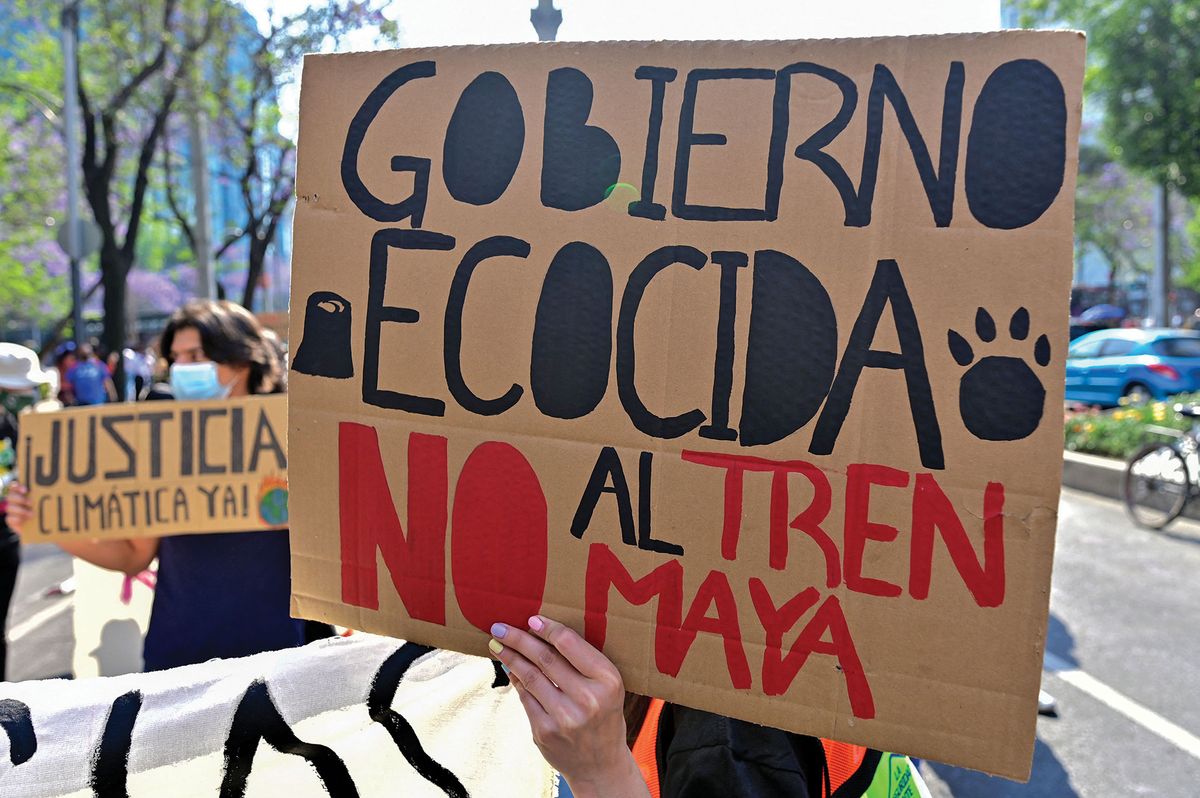Controversy surrounding Mexico’s Maya Train, the $9.8bn development of a high-speed line connecting key tourist destinations in the south-eastern Yucatán Peninsula, has reached a fever pitch as archaeologists and environmental activists increasingly speak out against the government’s execution of the mega-project.
Running 1,500km around the peninsula, the line includes around 20 stations between the ruined Maya city of Palenque in Chiapas and Cancún on the Caribbean coast in Quintana Roo. The rail project was a major election promise of the Mexican president Andrés Manuel López Obrador, who has been accused of rushing the development in order to complete it by the end of his term in 2024.
The government claims the Maya Train could double economic growth and alleviate poverty in the Yucatán, creating around one million jobs and making previously remote ancient sites more accessible to tourists. But its detractors say the government has not been transparent about the catastrophic risks it poses to ecological and archaeological heritage.
The project has been the target of protests since it broke ground in 2018 but recent demonstrations have focused on section five of the development near the resort town of Playa del Carmen. Activists argue that plans to reroute the train line through the rainforest—announced by Obrador in January—will cause irreversible damage to the environment and threaten ancient Maya sites. There are also fears that increased tourism will only worsen the existing problems of drug cartels and human trafficking.
There have already been collapses of cenotes—freshwater sinkholes formed naturally over millions of years in the Yucatán’s porous bedrock—between Playa del Carmen and Cancún, fuelling concerns that the new route could destroy more caverns, contaminate the ecosystem and impact the rich archaeological landscape. Cenotes were sacred to the ancient Maya, so the surrounding areas are often abundant with artefacts, altars and shrines. There are more than 40 examples of complex underground ritual temples in the region.
Army deployed
“The problem is that the area is still scarcely explored and we don’t know what else is around there,” says Miguel Covarrubias, an independent archaeologist with expertise in the Yucatán. “The Mexican government, calling us pseudo-environmentalists and pseudo-archaeologists, has deployed the army to make sure the project is on track. Obrador has even accused us of having been paid to oppose the project,” he says.
The Mexican government enlisted the federal heritage bureau—the Instituto Nacional de Antropología e Historia (INAH)—to conduct preliminary research and excavations along the Maya Train route. INAH has published reports of several discoveries to date, including more than 3,000 pre-Hispanic structures, more than 80 burial sites and thousands of rare objects like a well-preserved Maya canoe thought to be more than 1,000 years old that had been submerged in a cenote near Chichén Itzá.
Beyond INAH, however, archaeologists have not been granted access to the project. Based on accounts from local communities, activists allege that the Mexican government has concealed a significant number of archaeological finds and that sites are being exposed to looting.
“The mandatory research that must be done before construction begins is being done in a hurry and not with the quality required for archaeological research,” Covarrubias says. “The INAH doesn’t have the capacity to protect everything—it’s a small institute, with a low budget and very few archaeologists working there, some of whom are suspected of being bribed by private companies.”
In March, activists with Greenpeace Mexico tethered themselves to construction equipment in a peaceful protest that attracted the attention of the national media and the federal police. “The Mexican president then mentioned Greenpeace twice in his daily press conferences, saying that the purpose of the protest was to stigmatise his administration,” says Gustavo Ampugnani, the director of the environmental campaign group’s Mexico branch.
Ampugnani notes that the section five tracks were originally planned to be built parallel to the highway but were rerouted after opposition from tourist resorts. “The environment there was already altered, but when you move track three or five kilometres into the forest, then there’s a new set of problems, and there hasn’t been an environmental study that could show us the possible magnitude of the impact,” he says.
In late April, as we went to press, a district court ordered a temporary suspension of the works due to the lack of environmental impact studies, upholding a complaint filed by a group of environmentalists and speleologists. A hearing on 13 May will determine whether the suspension will be made permanent.
“The administration is just moving forward blindly and INAH anthropologists and archaeologists, who are government employees, told us during the protests that they are discovering many things but can’t speak up,” Ampugnani adds. “There are some Maya communities that received a very good payout, so they are happy and promoting the Maya Train, and others who received no compensation.”
The project is being financed by a tourism tax levied from the Yucatán region and federal funds diverted from other programmes, as well as a colossal 650% budget increase for the tourism department in 2021, of which 95% has been allocated to the train line. Representatives for INAH did not respond to a request for comment.


